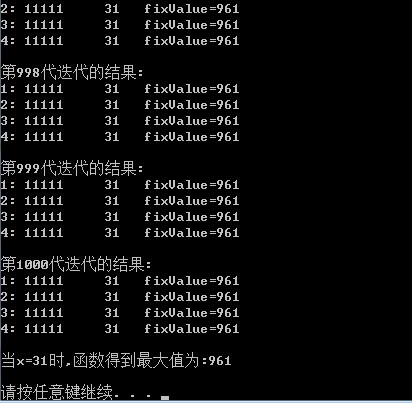人工智能--遗传算法 求解f (x) = x2 的最大值,x∈ [0,31]
/***********************************************************
** 人工智能--遗传算法
**
** 求解f (x) = x2 的最大值,x∈ [0,31]
**
**
/**********************************************************/
#include <stdio.h>
#include <string.h>
#include <stdlib.h>
#include <time.h>
#define TEST 0 //0:屏蔽所有的调试信息 1:开启所有的调试信息
#define TEST_FLAG 4 //1:测试randCreatePop函数 2:测试selection函数
//3.测试crossover函数 4.测试mutation函数
#define CROSS_RATE 0.5 //变异率(mutation rate)取值范围一般为0.4~0.99
#define MUT_RATE 0.09 //变异率(mutation rate)取值范围一般为0.0001~0.1
#define ITER_NUM 1000 //迭代次数(iteration number)
#define POP_NUM 4 //初始化种群的个数
#define GENE_NUM 5 //基因的位数个数
#define FUN_EXP(x) ((x)*(x)) //函数表达式
typedef unsigned int UINT;
//染色体的数据结构
typedef struct{
char geneBit[GENE_NUM]; //基因位(gene bit)表示方式
UINT fitValue; //适应值(fittness value)(衡量个体的优劣)
}Chromosome;
void randCreatePop(Chromosome *); //随机创建初始群体
void selection(Chromosome *); //选择(Selection):根据适应度选择优良个体(最优解)
void crossover(Chromosome *); //交叉(Crossover):染色体的片断(基因)进行交换
void mutation(Chromosome *); //变异(Mutation) :随机改变染色体片断(基因)的值
void updatePop(Chromosome *, Chromosome *);//更新种群
void printResult(Chromosome *); //打印结果(当x为何值时,f(x)最大)
UINT calcFitValue(UINT); //计算染色体的适应度值
UINT binToDec(Chromosome); //将类似二进制的基因位转化为十进制
void test(Chromosome *); //测试函数
int main(int argc, char *argv[])
{
int count; // 记录迭代次数
Chromosome curPop[POP_NUM]; // 初始种群
Chromosome nextPop[POP_NUM]; // 更新后种群
//随机创建初始群体
randCreatePop(curPop);
//开始迭代
for (count = 1; count < (ITER_NUM + 1); count++)
{
updatePop(curPop, nextPop); // 更新种群
selection(nextPop); // 挑选优秀个体
crossover(nextPop); // 交叉得到新个体
mutation(nextPop); // 变异得到新个体
updatePop(nextPop, curPop); // 种群更替
printf("\n第%d代迭代的结果:\n", count); // 输出当前迭代次数,即种群的代数
test(curPop); //输出结果
}//迭代结束
printResult(curPop); //打印结果(当x为何值时,f(x)最大)
system("pause");
return 0;
}//end of main
//创建初始群体
void randCreatePop(Chromosome *pop)
{
UINT i, j;
UINT randValue;
UINT value;
srand((unsigned)time(NULL)); //如果所有的函数都要使用到rand函数,只需要在先运行的函数使用一次srand即可
for (i = 0; i < POP_NUM; i++) // 从种群中的第1个染色体到第POP_NUM个染色体
{
for (j = 0; j < GENE_NUM; j++) // 从染色体的第1个基因位到第GENE_NUM个基因位
{
randValue = rand() % 2; // 随机产生0或者1
pop[i].geneBit[j] = randValue + '0'; // 将随机数(0,1)赋给基因位
}
value = binToDec(pop[i]); // 计算染色体基因对应的值
pop[i].fitValue = calcFitValue(value); // 计算染色体的适应度值
}
#if (TEST==1) && (TEST_FLAG==1) //测试
printf("\n随机分配的种群如下:\n");
test(pop);
#endif
}//end of createPop
//选择(Selection):根据适应度选择优良个体(最优解)
void selection(Chromosome *pop)
{
UINT i, j;
UINT sumFitValue; //总适应值
UINT avrFitValue; //平均适应值
float choicePro[POP_NUM]; //选择机会
Chromosome tempPop; //临时种群变量
#if (TEST==1) && (TEST_FLAG==2) //测试
printf("\n没有选择前的种群如下:\n");
test(pop);
#endif
// 根据个体适应度来排序(冒泡法) 降序
for (i = POP_NUM; i > 0; i--)
{
for (j = 0; j<(i - 1); j++)
{
if (pop[j + 1].fitValue > pop[j].fitValue)
{
tempPop = pop[j + 1];
pop[j + 1] = pop[j];
pop[j] = tempPop;
}
}
}
//计算出总适应值
sumFitValue = 0;
for (i = 0; i < POP_NUM; i++)
{
sumFitValue += pop[i].fitValue;
}
//计算出平均适应值(四舍五入,保留到小数点后1位)
avrFitValue = (UINT)(((float)sumFitValue / POP_NUM) + 0.5);
//计算出每个群体选择机会
for (i = 0; i < POP_NUM; i++) //群体的概率 = 群体适应值/总适应值
{ //平均概率 = 平均适应值/总适应值
//群体选择机会 = (群体的概率/平均概率)
choicePro[i] = ((float)pop[i].fitValue / sumFitValue) / ((float)avrFitValue / sumFitValue);
choicePro[i] = (float)((int)(choicePro[i] * 100 + 0.5) / 100.0);//保留到小数点后2位,四舍五入
}
//根据选择概率来繁殖(copy)优良个体、淘汰较差个体
//如果choicePro[i]==0淘汰复制一次最优的群体
for (i = 0; i < POP_NUM; i++)
{
if (((int)(choicePro[i] + 0.55)) == 0)
pop[POP_NUM - 1] = pop[0];
}
#if (TEST==1) && (TEST_FLAG==2) //测试
printf("\n经过选择的种群如下:\n");
test(pop);
#endif
}//end of selection
//交叉(Crossover):染色体的片断(基因)进行交换
void crossover(Chromosome *pop)
{
char tmpStr[GENE_NUM] = "";
UINT i;
UINT randPos;
UINT randValue;
// srand( (unsigned)time( NULL ) );
randValue = rand() % 100; // 随机产生0到49之间的数;
if (randValue >= (int)(CROSS_RATE * 100)) // randValue<50的概率只有50%,即变异率为0.5
{
#if (TEST==1) && (TEST_FLAG==3) //测试
printf("\n种群没有进行交叉.\n");
#endif
return;
}
#if (TEST==1) && (TEST_FLAG==3) //测试
printf("\n交叉前,种群如下:\n");
test(pop);
printf("\n交叉的位置依次为:");
#endif
//种群中个体染色体两两交叉
for (i = 0; i < POP_NUM; i += 2)
{
//crossover child i and child i+1
randPos = (rand() % (GENE_NUM - 1) + 1); // 随机产生交叉点,交叉点控制在1到(GENE_NUM-1)之间
strncpy(tmpStr, pop[i].geneBit + randPos, GENE_NUM - randPos);
strncpy(pop[i].geneBit + randPos, pop[i + 1].geneBit + randPos, GENE_NUM - randPos);
strncpy(pop[i + 1].geneBit + randPos, tmpStr, GENE_NUM - randPos);
#if (TEST==1) && (TEST_FLAG==3) //测试
printf(" %d", randPos);
#endif
}
// 为新个体计算适应度值
for (i = 0; i < POP_NUM; i++)
{
pop[i].fitValue = calcFitValue(binToDec(pop[i]));
}
#if (TEST==1) && (TEST_FLAG==3) //测试
printf("\n交叉后,种群如下:\n");
test(pop);
#endif
}//end of crossover
//变异(Mutation) :随机改变染色体片断(基因)的值
void mutation(Chromosome *pop)
{
UINT randRow, randCol;
UINT randValue;
// srand( (unsigned)time( NULL ) );
randValue = rand() % 100; // 随机产生0到99之间的数;
if (randValue >= (int)(MUT_RATE * 100)) // randValue<2的概率只有2%,即变异率为0.02
{
#if (TEST==1) && (TEST_FLAG==4) //测试
printf("\n种群中没有基因变异.\n");
#endif
return;
}
randCol = rand() % GENE_NUM; // 随机产生要变异的基因位号
randRow = rand() % POP_NUM; // 随机产生要变异的染色体号
#if (TEST==1) && (TEST_FLAG==4) //测试
printf("\n变异前,种群如下:\n");
test(pop);
printf("\n变异的位置:染色体号=%d 基因位号=%d\n", randRow + 1, randCol);
#endif
pop[randRow].geneBit[randCol] = (pop[randRow].geneBit[randCol] == '0') ? '1' : '0'; //1变为0, 0变为1
pop[randRow].fitValue = calcFitValue(binToDec(pop[randRow])); // 计算变异后的适应度值
#if (TEST==1) && (TEST_FLAG==4) //测试
printf("\n变异后,种群如下:\n");
test(pop);
#endif
}//end of mutation
//更新种群
void updatePop(Chromosome *newPop, Chromosome *oldPop)
{
UINT i;
for (i = 0; i < POP_NUM; i++)
{
oldPop[i] = newPop[i];
}
}//end of updatePop
//打印结果(当x为何值时,f(x)最大)
void printResult(Chromosome *pop)
{
UINT i;
UINT x = 0;
UINT optValue = 0; // 函数的最优值
for (i = 0; i<POP_NUM; i++)
{
if (pop[i].fitValue > optValue)
{
optValue = pop[i].fitValue;
x = binToDec(pop[i]);
}
}
printf("\n当x=%d时,函数得到最大值为:%d\n\n", x, optValue);
}//end of printResult
//计算染色体的适应度值
UINT calcFitValue(UINT x)
{
return FUN_EXP(x); //
}//end of calcFitValue
//将类似二进制的基因位转化为十进制
UINT binToDec(Chromosome pop)
{
UINT i;
UINT radix = 1;
UINT result = 0;
for (i = 0; i < GENE_NUM; i++)
{ //printf("%d", pop.geneBit[i]);
result += (pop.geneBit[i] - '0')*radix;
radix *= 2;
}
return result;
}//end of binToDec
void test(Chromosome *pop)
{
int i;
int j;
for (i = 0; i < POP_NUM; i++)
{
printf("%d: ", i + 1);
for (j = 0; j < GENE_NUM; j++)
printf("%c", pop[i].geneBit[j]);
printf(" %4d", binToDec(pop[i]));
printf(" fixValue=%d\n", calcFitValue(binToDec(pop[i])));
}
}








 本文介绍了一个使用遗传算法求解函数f(x)=x²最大值的C语言实现案例,定义了染色体结构并实现了随机创建种群、选择、交叉、变异等核心遗传操作。
本文介绍了一个使用遗传算法求解函数f(x)=x²最大值的C语言实现案例,定义了染色体结构并实现了随机创建种群、选择、交叉、变异等核心遗传操作。

















 8303
8303

 被折叠的 条评论
为什么被折叠?
被折叠的 条评论
为什么被折叠?










